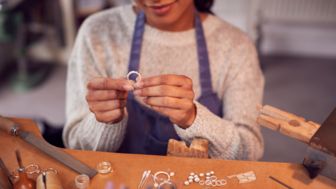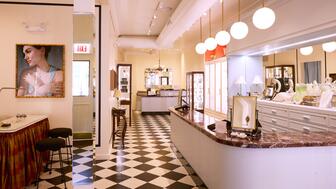The entrepreneur and “Shark Tank” star will share his top tips for success.
De Beers Cuts Price on Melee Screening Device
In addition to being cheaper, the diamond screening machine is also faster and better, De Beers said.

Hong Kong--De Beers has dropped the price of the device designed to automatically batch screen diamond melee by nearly half.
The second-generation Automated Melee Screener, or AMS, is priced at $45,000, compared with $85,000 ($55,000 plus a three-year, $10,000-a-year support and maintenance charge) for the first-generation version introduced to the market in 2014.
De Beers said the AMS2 also is about 10 times faster than its predecessor and has a substantially lower referral rate, meaning that fewer diamonds need further testing. A company spokeswoman said the referral rate on the AMS2 is less than 0.5 percent, compared with 2 percent on the first version.
Here’s how the AMS and AMS2 devices work.
A user can place up to 500 carats of melee in the machine at once. After the diamonds are inserted, the machine automatically feeds the stones, table down, into a testing station.
Once the stones are tested, they are dispensed into one of five bins:
-- Pass: The stone is not lab-grown or a simulant (meaning CZ, etc.);
-- Refer: More testing is needed;
-- Refer Type II: The stone has a low concentration of nitrogen and further testing is required as it might be lab-grown;
-- Non-diamond: The stone is a simulant or lab-grown; and
-- Purge: This bin is for when the user needs to empty out the machine because, for example, they put in the wrong packet of diamonds.
The AMS device can test colorless or near-colorless diamonds as small as one point and as large as 0.20 carats and was developed to separate man-made melee from natural stones in response to growing industry concerns about undisclosed lab-grown melee in the supply pipeline.
RELATED CONTENT: 5 Takeaways on the Lab-Grown Diamond Market
De Beers’ International Institute of Diamond Grading & Research developed the second-generation AMS device. The IIDGR is a De Beers-owned facility that develops diamond testing equipment and grades stones, and has developed the other products De Beers uses to screen for synthetics, the DiamondView, DiamondSure and PhosView.
When it initially opened, the lab graded only Forevermark stones but it began accepting all diamonds in February 2016. Those who want to send diamonds to the lab can visit the contact details area of IIDGR.com to inquire about the service they want.
The IIDGR has facilities in Maidenhead, United Kingdom; Surat and Antwerp.
De Beers unveiled the AMS2 at the International Diamond, Gem & Pearl Show this week in Hong Kong.
It will
Companies that had the original AMS machine include Kiran Gems, Tasaki, Rosy Blue and Stuller.
The Latest

The Ukrainian brand’s new pendant is modeled after a traditional paska, a pastry often baked for Easter in Eastern European cultures.

The jeweler has announced a grand reopening for its recently remodeled location in Peoria, Illinois.

The “Strong Like Mom” campaign features moms who work at Tiffany & Co. and their children.


Interior designer Athena Calderone looked to decor from the 1920s and 1930s when crafting her first fine jewelry collection.

During a call about its full-year results, CEO Efraim Grinberg discussed how the company is approaching the uncertainty surrounding tariffs.

Bench jewelers spend years honing their skills, Jewelers of America’s Certification validates their talents.

The free program provides educational content for jewelry salespeople and enthusiasts to learn or refresh their diamond knowledge.

The feedback will be used to prepare other jewelers for the challenges ahead, the organization said.

The online sessions are designed to teach jewelers to use AI tools like ChatGPT and Claude to grow their business.

The opening marks the jewelry retailer’s first location in the Midwest.

The “United in Love” collection offers tangible mementos of hearts entwined with traditional and non-traditional commitment heirlooms.

Robert Goodman Jewelers will hold a “Black Jewelry Designers and Makers” event on April 27.

The announcements follow a tumultuous start to 2025 for WJA, which saw a wave of resignations following controversial statements about DEI.

Editor-in-Chief Michelle Graff answers questions about how the new taxes levied on countries like India and China will impact the industry.

Kenewendo, Botswana’s minster of minerals and energy, discusses closing the deal with De Beers and the work that was missed along the way.

The historic fancy vivid blue diamond set to headline Christie’s Geneva sale next month could sell for up to $50 million.

LVMH CFO Cécile Cabanis also discussed the effects of tariffs so far.

The “Mad Men” and “The Morning Show” star steals jewelry, art, and handbags from his wealthy neighbors in “Your Friends & Neighbors.”

The organization has reelected Kalpesh Jhaveri as president.

An investigation found that the former managing director of Movado’s Dubai branch overstated and prematurely recorded sales.

The collection pays tribute to the Japanese philosophy of Ma, studying balance, stillness, and the interplay between presence and absence.

Mari Lou’s Fine Jewelry in Orland Park, a suburb of Chicago, is closing its doors.

These earrings by Van Cleef & Arpels, featuring the same design as a pair worn by Princess Grace, are up for auction at Woolley & Wallis.

Two experts share how artificial intelligence tools can help retailers run a more efficient business.

Kentaro Nishimura, who has been with the pearl company since 1997, has been promoted to president and CEO of Mikimoto America.





























